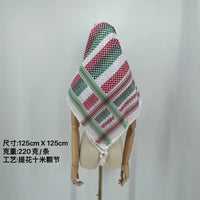The keffiyeh, also known as kufiyyeh, ghutrah, shemagh, or ḥaṭṭah, is a traditional headdress that has transcended its origins to become a symbol of cultural identity, resistance, and fashion. Worn predominantly by men in various parts of the Middle East, the keffiyeh is a versatile piece of attire that holds significant historical and cultural value. This article explores the origins, cultural significance, and the countries where the keffiyeh is commonly worn.
Origins of the Keffiyeh
The keffiyeh originated among Bedouins in the arid desert regions of the Middle East as a practical head covering to protect against the harsh sun, dust, and sand. Its name is derived from the city of Kufa in Iraq, highlighting its deep historical roots. Traditionally made from cotton, the keffiyeh is a square scarf that is folded and wrapped around the head in various styles.

Countries Where the Keffiyeh is Commonly Worn
1. Palestine
The black-and-white checkered keffiyeh is most famously associated with Palestine. It became a symbol of Palestinian identity and resistance during the Arab Revolt of 1936-39 against British rule. Yasser Arafat, the leader of the Palestine Liberation Organization (PLO), further popularized it as a symbol of Palestinian nationalism.
2. Jordan
In Jordan, the red-and-white version of the keffiyeh, known as the shemagh, is widely worn. It is a symbol of Jordanian heritage and is often worn by Bedouins and rural communities. The shemagh is also part of the uniform for the Jordanian military.

3. Saudi Arabia
In Saudi Arabia, the keffiyeh, known locally as the ghutrah, is typically white and is secured with a black cord called the agal. It is an integral part of traditional Saudi attire and is worn by men of all ages.
4. Iraq
In Iraq, the keffiyeh, also known as the jamadani, is worn by various ethnic groups, including Arabs, Kurds, and Turkmen. The patterns and colors can vary, with some regions favoring darker hues.
5. Syria
In Syria, the keffiyeh is worn in both black-and-white and red-and-white variations. It is a symbol of Syrian heritage and is commonly seen in rural areas.
6. United Arab Emirates, Qatar, and Bahrain
In the Gulf states, including the UAE, Qatar, and Bahrain, the all-white ghutrah is prevalent. It is a symbol of national pride and is worn daily by many men.
7. Yemen
In Yemen, the keffiyeh is worn in a turban style and is often paired with traditional Yemeni attire. The patterns and colors can vary, reflecting the diverse cultural heritage of the region.
Cultural Significance
The keffiyeh is more than just a piece of clothing; it is a symbol of identity, resistance, and solidarity. In Palestine, it represents the struggle for liberation and unity. The patterns on the keffiyeh, such as the fishnet design and olive leaves, hold significant meanings related to Palestinian culture and heritage.
In Jordan and Saudi Arabia, the keffiyeh is a symbol of national pride and traditional values. It is worn during national celebrations and important events, showcasing the rich cultural heritage of these countries.

The Keffiyeh in Western Culture
The keffiyeh has also made its way into Western fashion, often worn as a scarf or accessory. However, this adoption has sparked debates about cultural appropriation. While some wear it as a fashion statement, it is essential to recognize and respect its cultural and historical significance.
Conclusion
The keffiyeh is a powerful symbol that transcends borders and cultures. From its origins in the Middle East to its global presence, it represents resilience, identity, and tradition. Whether worn in Palestine, Jordan, Saudi Arabia, or beyond, the keffiyeh continues to be a meaningful and iconic piece of attire.
If you found this article informative, feel free to share it with others who might be interested in the cultural significance of the keffiyeh. Explore more about Middle Eastern traditions and their global impact in our related articles.





